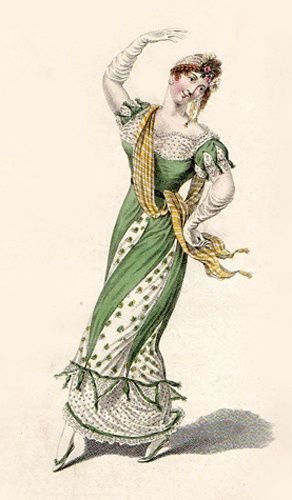Dancing at a Regency Ball

In a society governed by strict rules regulating the interaction of the sexes, the dance floor provided only of the only places marriage partners could meet and courtships might blossom. The ballroom guaranteed respectability and proper conduct for all parties since they were carefully regulated and chaperoned. Even so, under cover of the music and in the guise of the dance, young people could talk and even touch in ways not permitted elsewhere despite the supervision of chaperones.
Rules of the Dance Floor
A young woman did not dance more than two pairs of dances with the same man or her reputation would be at risk. Even two dances signaled to observers that the gentleman in question had a particular interest in her. Pairs of dances and usually lasted half an hour, so an undesirable dance partner could have been quite a burden, especially considering dancing in a large set involved a lot of standing around waiting one’s turn to dance. However, if one’s partner were pleasing company, it was possible to have private conversations under cover of the crowd.
The Dances
Dances of this era were lively and bouncy. Ladies pinned up the trains of their ball gowns for ease in performing the steps. This also signaled potential partners that they meant to dance that night.
Steps ranged from simple skipping to elaborate ballet-style movements. Country dances, the scotch reel, cotillion, quadrille made up most of the dancing. Many versions of these dances existed and often the lady of the leading couple would get to select the specific one that was to be danced.
In the country dance, a line of at least five couples progressed up and down the line in various figures as dancers would swing from partner to partner. As they reached the top, each couple in turn would dance down until the entire set had returned to its original positions. In large sets, this could take an hour to complete.
Country dances basically had only one step that was used to create various chain patterns and shapes along the dance floor. These dances were very flexible in the number they could accommodate.
Some insisted that reels were better suited to private balls than public assemblies because of their merry character. In this dance four, or sometimes six, dancers would perform interlacing figures with one another then pause for a sequence of fancy footwork similar to a Highland Fling.
The cotillion was a French import, with elaborate footwork. It was performed in a square or long ways, like the country dance. It consisted of a “chorus” figure unique to each dance which alternated with a standard series of up to ten “changes” (simple figures such as a right hand star) common to cotillions in general). Some considered cotillions out of fashion by 1800.
The quadrille was a dance for four couples, in a square. It consisted of five distinct parts or figures assembled from individual cotillions without the changes, making it a much shorter dance. The music for the dance was often adapted from popular songs and stage works.
One dance not likely to be found in a Regency era ball was the waltz. When it was first introduced, the waltz was regarded as shocking because of the physical contact involved. Even Lord Byron was scandalized by the prospect of people “embracing” on the dance floor. It was unlikely to have been seen often in public assemblies until the latter part of the Regency era, and even then, not often.
by Maria Grace Copyright 2013, all rights reserved

I loved watching the video clips!
So glad you enjoyed them!
Thank you for this lovely post. In Denmark we still dance Les Quadrille to this day. A very specific Quadrille none the less. We adopted The Lancers Quadrille from the Brits, stole the music form the French and added our own fifth turn at the end. It’s a dance that is still danced at the Royal Court, in the armed forces and at our high schools (called Gymnasiums in danish). From these institutions the dance find it’s way to other occasions and festivities.
I think it’s fascinating that such an old dance is still alive, though altered.
Have a nice Sunday.
Greetings from Nina in Denmark
I am so glad you enjoyed it. I would love to learn to dance these kinds of dances. I’ve signed up for a workshop in September, so perhaps then…